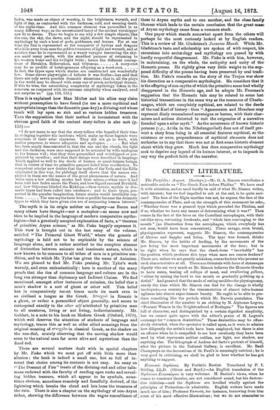CURRENT LITERATURE.
The Portfolio : August. (Seeleys.)—Mr. G. A. Simcox contributes a. noticeable article on "The Greek Face before Phidias." We have read it with attention, and as need hardly be said of what Mr. Simcox writes, with interest; but we feel impelled to ask at the end, is he quite seri- ous? The face of the Elgin marbles was not, he argues, the face of the contemporaries of Plato, and on the strength of this statement he asks,. "Whether there was a general type which preceded the Phidian, and if so, whether we have any means of determining what it was?" Then comes in the fact of the faces on the Castellani sarcophagus, with their cat-like eyes, retreating foreheads, and "whole face converging to the mouth" (an illustration from the sarcophagus, which everybody has not seen, would have been convenient). These savage, even brutal, physiognomies represent, suggests Mr. Simcox, the contemporaries of Alca3us and Sappho and Solon. The type wee formed, thinks Mr. Simcox, by the habits of feeding, by the movements of the jaw being the most important movements of the face ; but is he right when he says that the cheek-bone " inevitably " has the position which produces this type when men are coarse feeders ? There are, unless we are greatly mistaken, coarse feeders who present no- such characteristics at all. There are Orientals with faces of statuesque dignity who eat very much as Mr. Simcox believes the Homeric Greeks to have eaten, tearing off collops of meat, and swallowing pillatts, "either by raising the bowl to the mouth or gradually gobbling up a. fistful." And granted that the mode of eating modifies the physiognomy, surely the time which Mr. Simcox can find for the change is wholly inadequate,—a century for the transmutation of almost infra-human ugliness into almost super-human beauty. He ought to be able to pro- duce something like the periods which Mr. Darwin postulates. The chief illustration of the number is an etching by M. Alphonse Legros, "Peasant Women in the Neighbourhood of Boulogne." The figures are fall of character, and distinguished by a certain dignified simplicity, but we cannot quite agree with the editor's praise of M. Legros's contempt for "common dexterities." These dexterities may be offen- sively obtruded, when the spectator is called upon, as it were, to admire how diligently the artist's tools have been employed, but there is also an offence when he is compelled to see how carelessly they have been used by what represents neither outline, nor light, nor shadow, nor anything else. The lithograph of Andrea del Sarto's portrait of himself, after the picture in the National Gallery, is excellent. Mr. Basil Champneys on the decorations of St. Paul's is amusingly satirical ; he is very good in criticising, we shall be glad to hear whether he has got anything to suggest.






























 Previous page
Previous page